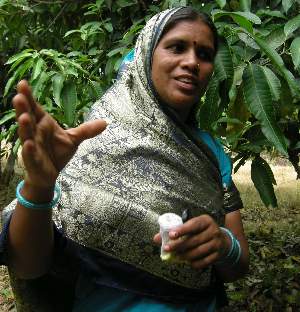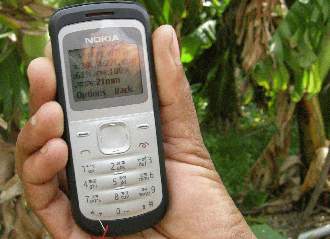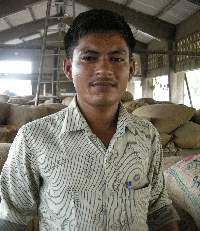Gondia and Nagpur: It is 8 am on a cloudy day in June. Sunita Bhajipale is anxiously awaiting a message on her cell phone, quite unusual for a woman farmer in Jhilmili village of Vidarbhas Gondia district. As the ringtone on her handset buzzes, Sunita smiles and checks the message. Not a good time to start sowing yet, she says.

![]() Sunita Bhajipale, a progressive woman farmer and an RML subscriber, at her farm in Jhilmili village in Gondia district of Maharashtra. Pic: Jaideep Hardikar.
Sunita Bhajipale, a progressive woman farmer and an RML subscriber, at her farm in Jhilmili village in Gondia district of Maharashtra. Pic: Jaideep Hardikar.
The SMS she received is the latest weather advisory from Reuters Market Light (RML), a professional content service for farmers from the Thomson Reuters Group. RML is my friend, she says as she decodes the message: 95% chance of rains, 2 mm rain. It might rain today, but not enough to commence sowing. Lets wait for two days, she asserts.
Among the progressive big farmers, the entire Bhajipale family, comprising several brothers and cousins, collectively owns 100 acres of land and is into experimenting new cost-effective farming techniques and new crops from grains to vegetables to fruits. RML, they say, has augmented their income.
Four text messages a day at an annual subscription of Rs 800, Sunita says, is not bad. We get all information about weather, crop, commodity prices at different markets, and future projections.
Thanks to daily updates, the Bhajipales have been able to jack up their profits by at least Rs 1 lakh with just one years RML subscription. Until last year, we sold our bananas to traders at Bhandara or Gondia at a price they quoted. Now we show them the RML messages if they quote less, she says. It helps us in making informed decisions on whether we should sell our produce or wait.
RML, a silent revolution
Welcome to the ICT-enabled farming. It is a complex web of activities that is, on the one hand, revolutionising the way content is generated, tailor-made, and disseminated. And on the other, it is helping the peasants use the information to do smart farming and make informed choices like which crop to sow, when and where to sell the produce.
RML ideated in Stanford, California, US; incubated in London; and tested in Vidarbha is making silent but deeper penetration into the vast Indian rural landscape. From a few thousand subscribers who received the service free of cost during a test-run in 2007, RML today reaches 250,000 peasants in 13 states, signalling a staggering growth driven by greater rural consumer interest. Not to mention the ripple effects it creates when one RML-subscribed farmer passes on the information to his fellow-villagers.

•
Cotton marketing fails Vidarbha farmers
•
Vidarbha meltdown: bumper crop losses
Plus, India has 150 million farming households, largest in the world. To top it all, Bangalore is the hub of the Reuters global data operations. All these features, the project think tank thought, would naturally aid the project in accessing technology and tackling the initial hiccups.
The Reuters Innovation Foundation formed a team that looked at the potential test field. Maharashtra, Vidarbha in particular, emerged as a choice because of significant farming population, deeper rural penetration of mobile network, marketable surplus of commodities, and internal assessment.

![]() Cellphone flashing an RML advisory. Pic: Jaideep Hardikar.
Cellphone flashing an RML advisory. Pic: Jaideep Hardikar.
According to RML Vice-President (Operations) Ranjit Pawar, a lot of field research and consumer feedback was carried out in the first year (2006). We engaged research agencies to know the top-most information needs of the Indian farmers.
The research assumptions were obvious: there was information asymmetry, farmers did not get timely crop and weather advisories, and the information about schemes and government programmes was hardly accessible. When consumer surveys were analysed, the assumptions stood vindicated.
Based on the subscribers feedback, RML synthesized prototypes of text messages and sent it to some farmers in Maharashtra, particularly Vidarbha. They liked what they saw, Pawar says.
Pilot project
In 2007, a pilot product was launched. Instead of providing the product on the java-enabled mobile handsets, the RML team chose to provide text services to the universally used handsets. The technological change was from application-based to text messaging. This made things easier for the farmers to receive and understand the content.
We could have tested it in two-three states, Mehra says. But we decided to test it first on a small scale in Maharashtra before scaling up the operations in 13 other states.
How it works
As farmers continue to take their own lives in their hundreds, a credible information and extension services (which were otherwise a key role of the state agriculture universities and departments) through cell phones are aiding some of the user-farmers in their decision-making process.
This first-year BA student is a farmers son and RMLs market correspondent. Hes our eyes and ears at the local mandi, says Shrinivas Pande, chief market reporter. Every day, between 11 am and 5 pm, Sarang taps on the prices at this market of 20 different commodities from fruits to grains to vegetables.
After cross-checking his message, Sanrang shoots it to a systems unique short code, after which it gets structured at the Reuters data centre in Bangalore before appearing in minutes on an internal prices application portal. Sitting in his Nagpur office, Pande surfs through the messages on his laptop when he taps on Sarangs entry. It reads: soybean maximum price-2024, minimum price-1951, average price-1975, arrival at Kalamna market-800 quintals; wheat maximum price-1199, minimum price-1176, no average (since only two auctions took place that particular day), arrival-700 quintals
Pande clicks approved. The message heads to the production desk and is ready for dissemination. In an instant, it reaches the subscribers as per their market and commodity preferences.
RML sources about 5,500 data points, of which 680 are in Maharashtra. For instance, soybean prices at Nagpur market forms one data point. Local level market reporter is the primary source and foundation of the Market Light product. The Reuters editorial network and its premium services are its backbone.
The whole of market intelligence is available to farmers for whom it reads like a simple text message. But the challenge is in synthesising of a complex set of fast-paced global activities: from collecting data, deciphering it, and disseminating it in a way that can be easily read and understood even by illiterate peasant subscribers.
Global market intelligence and information is sourced from various market reports and analyzed by experts. Granular information and intelligence is collected by market reporters posted at APMC markets.
RMLs USP
Its affordable, easily accessible, and customized for the needs of individual farmers. If you choose to get information on soyabeans and cotton, two major globally traded crops of Vidarbha, youll get it. At any stage, if you intend to change your choices, you could do so by dialling a toll-free number.
When the idea got coined, we said, we now have the device that makes it possible, workable. It only had to be affordable and accessible for farmers, says Mehra.
It is simple and user-driven. All that you do is dial 18002708090, a toll-free number to enquire about RML. Buy a scratch card available at retail shops and Krishi Gramin Bank branches and follow a couple of simple steps to get the service activated. What makes the service spread fast is easy access from any handset and mobile operator. There are no language barriers either since the farmers can get messages in any regional language of their preference.

![]() RML market reporter Sarang Pimpale at Nagpur's Kalamna Market yard. Pic: Jaideep Hardikar.
RML market reporter Sarang Pimpale at Nagpur's Kalamna Market yard. Pic: Jaideep Hardikar.
If you hear Sunita, it becomes clear why she subscribed to the service when she first heard of it at a farmers convention in the district. I needed this information. It gives us an edge and confidence, she says. This need, in essence, is what creates business opportunity for RML. This ones a new segment of customers and a new area for content generation.
Pawar says RMLs weather updates, drawn from both local and overseas professional weather forecast services, is one of the top four information needs of a farmer.
RMLs content-spread is mind-boggling. It covers 250 crops; 1,000 markets and 3,000 weather locations. So is the size of operations: 300 people in 13 states source information at granular levels. Another 13 editors source information from global markets and keep a tab on the global commodity trends, activities at the Chicago Board of Trade, and dozens of advisories issued by governments worldwide.
Farmers avert losses
A number of subscribers reported that the RML advisories helped them avert potential losses by reacting quickly to weather and pest information resulting in generated positive economic benefits.
Take for instance, Ravindra Lindal, a marginal farmer in Beeds Rohtalgaon village. Two years since he subscribed to RML, Lindal has preserved every single advisory he received on his cell phone. Last season, his profits went up by Rs 64,000.
One SMS advisory suggested that soybean prices would drop in a weeks time and I decided to sell my produce immediately, he says adding that he would not have sold the output otherwise. The prices did drop. I was saved.
What we do is manage the risks at one level and try to maximize the farmers gains at another, says Pawar. We give them information and leave the decisions to them.
In highly volatile global markets, getting accurate market intelligence and a picture of future trends are crucial to the farmers who had no access to such specific information earlier, says RML editorial head Sunil Tambe.
The RML subscribers benefited immensely last year when markets were bearish, in contrast to the long-term experience. Our analysis showed that soybean prices would collapse later, because of the bumper crop in Agrentina and South Africa. The prices usually start to climb at a later stage. The RML subscribers told us they sold the crop early and averted the losses. As for cotton, our advisories suggested a rising trend in global prices at a later stage, so the farmers decided to wait, adds Tambe.
According to Tambe, the content has evolved and been shaped by the subscribers over the time. RML equips the farmers with market intelligence and keeps them updated on prices of different markets to help them understand broader current trends and future projections. Now the farmers growing soybeans in Vidarbha want to know the plant delivery prices meaning the procurement price at soya oil extraction plants. This information gives them an idea of the global trends and the market situation.
Other models
So far, it remains the only commercial mobile-enabled information service for farmers in India. A few other area-specific parallels such as IKSL are non-commercial and do not provide country-wide service. IKSL, run in partnership with Bharti Airtel by the Indian Farmers Fertilisers Co-operative Ltd (IFFCO), requires the farmers to purchase a special SIM card to receive free voice-mails on agricultural information at Rs 1 per minute.
The MS Swaminathan Research Foundation (MSSRF), a Chennai-based NGO, is piloting a mobile information services model for fishermen in partnership with Qualcomm, a global technology company, and Tata Teleservices, an Indian mobile phone operator. The programme, Fisher Friend, provides free mobile handsets to fishermen along with free access to the information service.
Similarly, agribusiness company ITC also operates several models of a rural internet kiosk programme, the e-choupal, serving farmers across rural India. The version investigated for this report was anchored upon an internet kiosk manned by a local farmer who acts as an agent for ITC called sanchalak.
Last year, a research carried out by ICRIER on the Impact of Mobile Phones on Agriculture Productivity found evidence that mobiles are being used in ways which contribute to productivity. When compared to other models, the ICRIER researchers found the RML model most suitable to the farmers because of its customized nature and easy access.
Ready for expansion
Now that the product is replicable and foolproof, RML is ready to sail beyond the Indian shores. We are gearing up to introduce the product in other developing countries. Thats the reason why we scaled it up in India because its a model that works accurately, says Mehra.
A success story
Internal analysis says the farmers have been benefited up to Rs 2 lakh
Economic model is purely subscription-based; its a business and not a CSR activity
Three-month plan comes at Rs 250; six-month at Rs 500, and annual, Rs 800
Farmers first want to have a taste of the product. So they first subscribe to a three-month plan before going for a long-term plan. The trend is that RML is retaining customers.
The value chain, Pawar says, is equally important. The Thomson Reuters does everything on its own: sources the content, manages it, disseminates it on its own, looks after the billing and sales (it has its own pre-paid vouchers), and also handles customer care and support.
Subscribers information consumption behavior is changing, Pande asserts. Earlier, they expected a message once in 3-4 days; now they want it a few times a day, particularly in harvest season. Some curious farmers call RML reporters any time to know more about crop and market situation and newly launched government schemes.
It can play a big role in extension, Gondia sub-divisional agriculture officer Rajratan Kumbhare says. I see a qualitative change in the way RML subscribers take to farming aided by this information.
Farmers like Sarjerao Sahebrao Kharwade, who owns a five-acre rain-fed strip in Beeds Gevrai tehsil, are already blending their wisdom with advisories. Im able to sell my produce at an appropriate time, he acknowledges. I am sticking with it since its giving me dividends.























